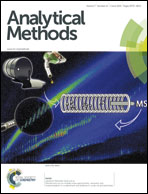A novel iron oxide nanoparticle-based method for the determination of the antioxidant capacity of rapeseed oils at various stages of the refining process
Abstract
A novel iron oxide nanoparticle-based (IONP) method and two modified methods: ferric reducing antioxidant power (FRAP) and 2,2′-diphenyl-1-picrylhydrazyl (DPPH) were used for the determination of the antioxidant capacities of the acetonic, ethanolic and methanolic extracts of rapeseed oils from different stages of technological processes. The IONP method based on the reduction of ferric ions by oil antioxidants in acidic medium and the formation of yellow solutions of iron oxide nanoparticles (IONPs) has been elaborated. The novel IONP method was validated using sinapic acid (SA), caffeic acid (CA), gallic acid (GA), ferulic acid (FA), vanillic acid (VA) and Trolox (TE) as standard antioxidant solutions. The average antioxidant capacities of the studied rapeseed oils ranged between 2594 and 4946 μmol SA/100 g for the proposed IONP method, 58–315 μmol SA/100 g for the FRAP method, and 462–1511 μmol SA/100 g for the DPPH assay. Satisfactory values of precision (RSD = 0.5–3.4%) demonstrate the benefit of the proposed IONP method for analysis of the antioxidant capacity of rapeseed oil samples.


 Please wait while we load your content...
Please wait while we load your content...